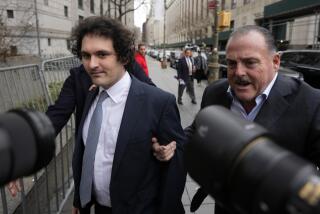Pioneer Investors Could Recoup 35 Cents on Dollar in Proposed Plan : Finance: But it could take five years to complete paybacks; some think the value would plummet by then.
- Share via
Pioneer Mortgage investors could recoup 35 cents on the dollar from investments in the now-bankrupt firm, according to a lengthy disclosure statement filed Thursday in U.S. Bankruptcy Court by Pioneer and its creditors committee.
Investors could receive a partial payment late this summer, according to the disclosure statement. However, it could take an additional five years to complete an orderly sale of the troubled firm’s assets, according to the complex, 128-page disclosure statement.
The filing, though replete with cautionary language and caveats, marked the first official estimate of what investors can expect to retrieve from investments made through Pioneer, a La Mesa-based mortgage broker.
Before entering Chapter 11 bankruptcy proceedings in January, 1991, Pioneer arranged $200 million in real estate loans for 2,000 investors. Most of the loans subsequently failed, and investors have long feared that they would lose most of their money.
The estimated return of 35 cents on the dollar was submitted by the bankrupt company’s new management and Pioneer’s creditors committee. The 35-cent return, which is based on current estimates of assets to be liquidated if the plan is confirmed, is contingent on all investors agreeing to take part.
If the statement is confirmed, investors would transfer their interests in notes and deeds secured by real estate to the liquidating company. The liquidating company would pool the assets and make pro-rated payments, based on investors’ individual interests, as assets are sold.
Investors who opt not to take part in the plan are free to seek resolution of claims through the court.
Although the document offers the best estimate available of the return investors can expect, it is filled with cautionary language. One section, for example, notes that estimates “may prove to be incorrect and are highly speculative and problematic” given California’s unstable financial and real estate markets.
Investors contacted Thursday were hesitant to discuss the document, which will not be circulated unless U.S. Bankruptcy Court Judge James W. Meyers approves it at a May 5 hearing.
However, Dee Dee Shulman, a Los Angeles resident, said the 35-cent estimate “was higher than I thought it would be. I really didn’t think it would be that high.”
Another out-of-town investor questioned what the 35-cent figure would be worth when the bankruptcy case finally concludes several years from now. “Thirty-five cents in five years is not worth what 35 cents is worth now,” the investor said.
Another investor, who asked that his name not be used, said the estimate was too rosy. “My own gut feeling is that we’ll be lucky to get 15 cents on the dollar,” the investor said.
Meyers now must determine if the disclosure statement contains sufficient information for creditors to make an informed decision about the proposed plan.
“From the creditors committee perspective, this is a very important event that gets us closer to being able to make distributions to our constituents and bringing this to a close,” said Ali Mojdehi, an attorney who represents the creditors committee.
The disclosure statement calls for Pioneer to continue with the sale of Pioneer’s troubled assets. However, Pioneer would not be permitted to seek new business. And current President Dennis Schmucker would resign as soon as the plan is confirmed.
The asset sale would be conducted by a new company, Pioneer Liquidating Corp., which would be guided by the court and an independent board of directors to be selected by Pioneer’s creditors, the current management team and Pioneer’s court-appointed examiner.
Mojdehi said investors would be better served by allowing Pioneer to remain in Chapter 11 bankruptcy proceedings because Pioneer Liquidating Corp. would have the time needed to conduct “a controlled asset sale.”
Although the alternative, a Chapter 7 bankruptcy proceeding, could be completed in about a year, the return to investors likely would be lower because the company would be forced to unload assets when the real estate market is severely depressed, Mojdehi said.
“A Chapter 7 proceeding would be pretty uncontrolled,” Mojdehi said. “If you do the Chapter 7, you lose a lot of the (investor) protections which are built into the plan.”
The statement filed Thursday does not affect civil lawsuits that disgruntled Pioneer investors have filed in federal and state courts. The suits, which seek damages, allege fraud on behalf of former Pioneer President Gary Naiman and some of his former business associates.
More to Read
Inside the business of entertainment
The Wide Shot brings you news, analysis and insights on everything from streaming wars to production — and what it all means for the future.
You may occasionally receive promotional content from the Los Angeles Times.










